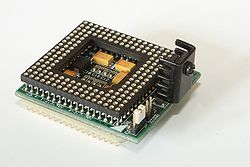
Intel 80486DX4
Encyclopedia


CPU multiplier
In computing, the clock multiplier measures the ratio of an internal CPU clock rate to the externally supplied clock. A CPU with a 10x multiplier will thus see 10 internal cycles for every external clock cycle...
i486 microprocessor
Microprocessor
A microprocessor incorporates the functions of a computer's central processing unit on a single integrated circuit, or at most a few integrated circuits. It is a multipurpose, programmable device that accepts digital data as input, processes it according to instructions stored in its memory, and...
with 16 kB L1 cache. Intel named it DX4 (rather than DX3) as a consequence of litigation with AMD over trademark
Trademark
A trademark, trade mark, or trade-mark is a distinctive sign or indicator used by an individual, business organization, or other legal entity to identify that the products or services to consumers with which the trademark appears originate from a unique source, and to distinguish its products or...
s. The product was officially named the IntelDX4, but OEM
Original Equipment Manufacturer
An original equipment manufacturer, or OEM, manufactures products or components that are purchased by a company and retailed under that purchasing company's brand name. OEM refers to the company that originally manufactured the product. When referring to automotive parts, OEM designates a...
s continued using the i486 naming convention.
Intel produced IntelDX4s with two clock speed steppings: A 75 MHz version (3× 25 MHz multiplier), and a 100 MHz version (usually 3× 33.3 MHz, but sometimes also 2× 50MHz). Both chips were released on March 1994. A version of the IntelDX4 featuring write-back cache was released in October 1994. The original write-through versions of the chip are marked with a laser embossed "&E", while the write-back enabled versions are marked "&EW". i486 OverDrive
Intel 80486 OverDrive
The Intel's i486 OverDrive processors are a category of various Intel 80486s that were produced with the designated purpose of being used to upgrade personal computers. The OverDrives typically possessed qualities different from 'standard' i486s with the same speed steppings...
editions of the IntelDX4 had locked multipliers, and therefore can only run at 3× the external clock-speed. The 100 MHz model of the processor had an iCOMP rating of 435, whilst the 75 MHz processor had a rating of 319. The IntelDX4 was an OEM-only product, but the DX4 Overdrive could be purchased at a retail store.
The IntelDX4 microprocessor is mostly pin-compatible
Pin-compatibility
In electronics, a pin-compatible device, such as a logic integrated circuit , memory module or microprocessor, is one that has the same functions assigned to the same particular pins....
with the 80486, but requires a lower 3.3V supply. Normal 80486 and DX2 processors use a 5V supply; plugging a DX4 into an unmodified socket will destroy it. Motherboards lacking support for the 3.3V CPUs can sometimes make use of them using a voltage regulator (VRM) that fits between the socket and the CPU.
IntelDX3
The IntelDX3 was intended to make use of a 2.5× multiplier (used by the Socket3 Pentium Overdrive), using the same die as the IntelDX4. For unknown reasons the IntelDX3 was never released. In the official white papers for the IntelDX4 there are instructions for enabling the 2.5× multiplier, however the feature was not implemented in the production version.S-Specs
| Processor Speed (MHz) | Input Clock (MHz) | Voltage Center (V) | Voltage Range (V) | Part Number | Clock Multiplier | S-Spec Number |
|---|---|---|---|---|---|---|
| 75 | 25 X 3 | 3.3 | 3.1 - 3.6 | FC80486DX4-75 | 3X mode only | SK052, SX883 |
| 100 | 33 X 3 | 3.3, 3.45 | 3.1 - 3.6 | FC80486DX4-100 | 3X mode only | SX906 |
| 100 | 33 X 3 / 50 X 2 | 3.45 | 3.3 - 3.6 | FC80486DX4-100 | 3X or 2X mode | SX876 |
| 100 | 33 X 3 / 50 X 2 | 3.3, 3.45 | 3.1 - 3.6 | FC80486DX4-100 | 3X or 2X mode | SK053 |
| 75 | 25 X 3 | 3.3 | 3.1 - 3.6 | A80486DX4-75 | 3X mode only | SK047, SX884 |
| 100 | 33 X 3 | 3.45 | 3.3 - 3.6 | A80486DX4-100 | 3X mode only | SK051, SX900 |
| 100 | 33 X 3 / 50 X 2 | 3.45 | 3.3 - 3.6 | A80486DX4-100 | 3X or 2X mode | SX877 |
| 100 | 33 X 3 / 50 X 2 | 3.3 | 3.1 - 3.6 | A80486DX4-100 | 3X or 2X mode | SK050 |
| 100 | 33 X 3 | 3.45 | 3.3 - 3.6 | A80486DX4WB-100 | 3X mode only | SK096 |
| 100 | 33 X 3 / 50 X 2 | 3.3 | 3.1 - 3.6 | A80486DX4WB-100 | 3X or 2X mode | Limited availability |
| 75 | 25 X 3 | 3.3 | 3.1 - 3.5 | A80486DX4WB-75 | 3X mode only | SK102 |
| 100 | 33 X 3 / 50 X 2 | 3.3 | 3.1 - 3.6 | FC80486DX4WB-100 | 3X or 2X mode | SK099 |
| 75 | 25 X 3 | 3.3 | 3.1 - 3.5 | FC80486DX4WB-75 | 3X mode only | SK100 |
External links
- http://www.olympusmicro.com/micd/galleries/chips/pages/intel486dx4a.html — photomicrograph of a DX4 microprocessor

